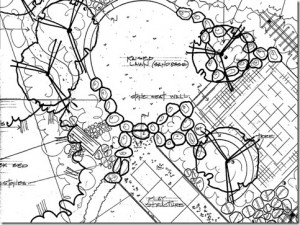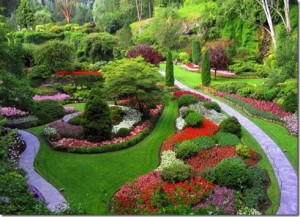





It has been suggested in the previous posts, that to make a successful garden you should take a long, hard look at what you have, look first at the whole site (however small) from all angles. Note especially views from the important windows of the house. Consider the basic shape. List all the plants that you have inherited and get them named. If you do not recognise them then the local garden centre or nursery will usually help if you take them a flowering or fruiting spray in good condition. Remove as little as possible at first and never cut down a tree until you are absolutely certain that it cannot be a part of your design, or you may regret it evermore. It takes decades to grow again anything as mature; and a feeling of maturity is of inestimable value in a garden. This is something which cannot be bought at any price.
In noting what plants are in your own and nearby gardens you will learn something about the soil . You will also have gathered something about the climate of the area through what grows well there. Obviously sheltered plots in warm areas will permit a much more exciting range of plants to grow than will chilly, exposed situations. Extraordinarily, the same dull old plants are seen in both extremes of climate and everywhere else too.
Observe the aspect, the view (if any) and prevailing winds.
Maintain a balanced optimism and, like the old Sunday school hymn:
‘Count your blessings
Count them one by one …’
This is not meant in any way to be a plan to be followed but merely for use as an aide mem0ire. It incorporates most of the likely desiderata of a small garden and, in fact, crams in more than could sensibly be used in such a site. But, apart from referring to other parts of the website as a sort of visual index, this is also a way of helping to sort out and choose ‘what do I want in my garden?’
 Draw a site plan to a large scale, list the requirements on individual scraps of paper and shuffle them about from place to place — preferably sitting at a table by the main window overlooking the garden — until a logical and pleasing combination of parts is built up.
Draw a site plan to a large scale, list the requirements on individual scraps of paper and shuffle them about from place to place — preferably sitting at a table by the main window overlooking the garden — until a logical and pleasing combination of parts is built up.
Beautiful gardens have been made in the most unpromising sites.
Do try to keep something of a garden website or diary; it will be of enormous help as your garden develops and of absorbing interest in the future as you look back on the successes and even the failures of years past. Noting and listing the plants is important, but is just a preliminary.
‘What have I got?’ is inevitably and rightly followed by the balancing question: ‘What do I want?’ Indeed the garden owner, raring to go, may well reverse the order of these questions — but he should not avoid the other. Only the owner and his family can really give answers to the question ‘What do I want’ and in doing so begin to make their garden personal.
In this website we look at a number of possible answers but the permutations are endless. The plans and comments must be seen as suggestions to be considered in part, rather than blueprints to be used en bloc. Do not forget the integral character of the place, which must be worked with.
One central concept, however, does need emphasising; that a garden should be considered as an extension to the house as a place for living in. Because of the vagaries of a northern climate it has taken a long time to be accepted that although many meals and snacks can be taken outside for almost half the year, an idealised Mediterranean life is neither possible nor desirable.
 Modern houses are seldom big enough so it seems absurd not to use the space that immediately adjoins the living rooms. No doubt it is more effort to take laden trays outside and bring back the dishes but, apart from the pleasure of being outside on a fine day, one does not have to worry nearly so much about young children dropping crumbs or spilling orange juice. The birds will eat the former and the latter just happily soaks in.
Modern houses are seldom big enough so it seems absurd not to use the space that immediately adjoins the living rooms. No doubt it is more effort to take laden trays outside and bring back the dishes but, apart from the pleasure of being outside on a fine day, one does not have to worry nearly so much about young children dropping crumbs or spilling orange juice. The birds will eat the former and the latter just happily soaks in.
The initial decisions of the design, then, must be based upon the balance of the parts making up the whole. In a very small town garden virtually everything becomes the outdoor room which is already enclosed by walls or other buildings.
In a bigger plot the ‘living area’ is just a part, hopefully that part leading directly from the indoor living area. A northerly aspect, however, would preclude such convenience.
It is almost inevitable that the rest of the garden is observed or glimpsed from the outdoor room or terrace. But let it be accepted that the outdoor living area is the most important part; the hub of the garden. Other parts of the design depending upon the answers to ‘What do I want?’, then fall into place much more easily. It is a good area from which to start.
Copyright © www.100flowers.win Botanic Garden All Rights Reserved